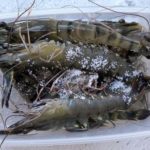1. Shape of the Shrimp
Frozen shrimp that have been injected with chemicals or are starting to spoil tend to have curved, rounded bodies.
Fresh shrimp, on the other hand, will have straight bodies, or only a slight curve if they’re smaller in size. Fresh shrimp will not feel unusually thick or plump. Shrimp that have been injected with water or chemicals to increase their weight will often have puffed-up bodies.

2. Shrimp Body and Head
The head and body of fresh shrimp should be firmly attached. In contrast, the heads of spoiled shrimp will be loose and easily detachable.

3. Shrimp Tail
Here’s a tip for buying shrimp that many may not know: checking the tail can help determine its freshness. Simply hold the shrimp up to the light, stretch out its body, and examine the width of the joints between the shell and the meat. If the joints are wide, it indicates that the shrimp has been stored for a while or kept in the refrigerator for too long. The fresher the shrimp, the narrower these joints will be.
Additionally, if the shrimp feels gritty under your fingers or is slimy and sticks together, it’s best not to buy it.

4. Shrimp Legs
When buying shrimp, pay attention to the legs. They should be firmly attached and curved. Avoid shrimp with straightened legs that have turned black, as this indicates they are no longer fresh.

5. Sliminess
Don’t buy shrimp that have become slimy.
You can gently press on the shell and move your finger along the shrimp’s body. If it feels gritty or slimy, it’s best to avoid purchasing them.
6. Shrimp Agility
If you’re choosing live shrimp from a tank, test their agility. It’s best to select shrimp that are actively swimming and have strong, quick movements. Shrimp that lie still in the tank or only move their legs are likely older and less fresh.
How to Identify Shrimp Quality
When selecting live shrimp from a tank, test their agility. Opt for shrimp that are actively swimming and display strong, quick movements. Shrimp that lie motionless in the tank or only move their legs are likely older and of inferior quality.
Tip for Storing Shrimp to Keep Them Fresh for Up to a Month
Step 1: Prepare the Shrimp
First, when you buy shrimp, trim their long antennae, then rinse them thoroughly and let them dry. Avoid letting the shrimp drip onto other foods to prevent cross-contamination.
Step 2: Store the Shrimp
Get a container with a tight-fitting lid. Place a layer of shrimp at the bottom, then sprinkle a layer of sugar on top. Repeat this process until the container is almost full, finishing with a final layer of sugar. Finally, close the lid and place the container in the freezer.

This method helps protect the shrimp meat from bacterial contamination, but it’s important not to store fresh shrimp for too long (no more than 30 days) as it will lose its nutritional value over time.
When you’re ready to cook the shrimp, move them to the fridge to thaw, which should take about four hours.

Note: Don’t put too many shrimp in one container, as you’ll have to thaw them all at once. If you don’t use them all, putting them back in the freezer will cause them to deteriorate quickly, affecting their taste and nutritional value. It’s best to divide the shrimp into smaller containers, enough for one meal each. This way, they’ll stay fresher, and it will be more convenient for thawing and cooking.
When you’re ready to cook, just thaw and prepare the shrimp as desired. With this storage method, whether you steam or cook them in a dish, the shrimp will retain their fresh taste, staying tender and flavorful without becoming mushy or bland.
According to Xe và thể thao
Preserving Shrimp: Don’t Freeze Them, Try This Method Instead for Fresh and Flavorful Results
Introducing the ultimate guide to preserving shrimp freshness! Forget the old ways of storing shrimp, as they tend to turn black and spoil over time. It’s time to embrace a new technique that will keep your shrimp fresh and tasty for longer. With this method, you’ll be able to enjoy your shrimp at their best, ensuring a delightful culinary experience every time. Stay tuned to unlock the secret to shrimp longevity!



































